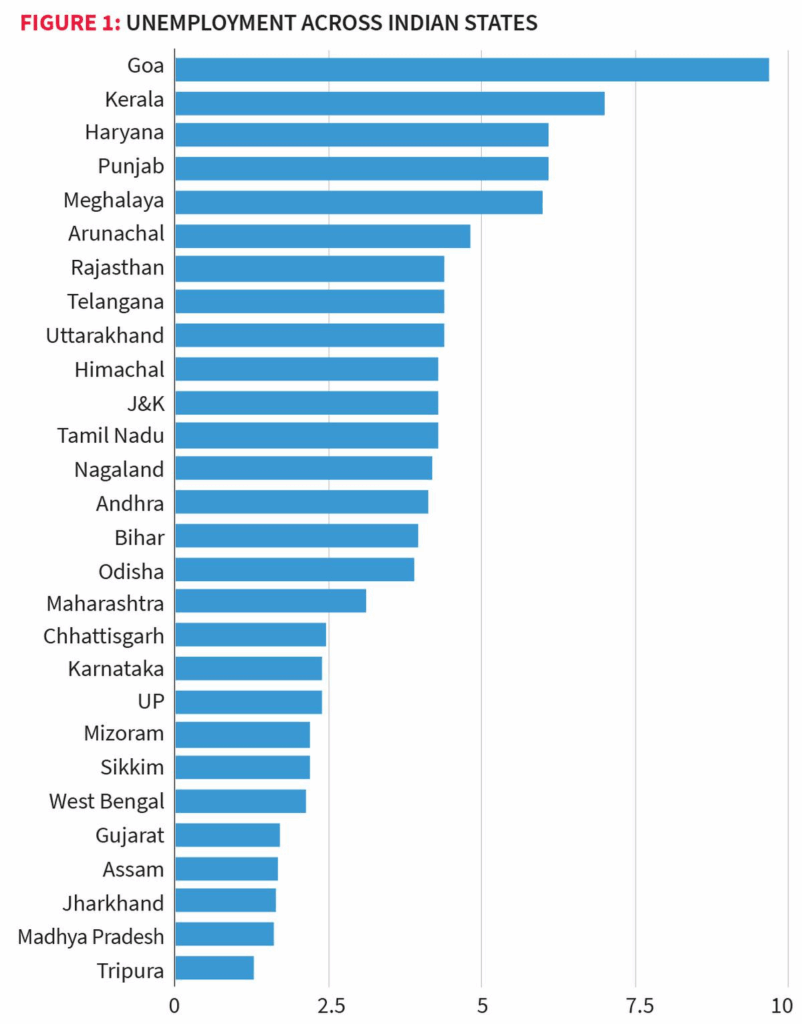By Dr. Gyan Pathak
The Periodic Labour Force Survey (PLFS) Monthly Bulletin for May 2025 has revealed that unemployment rate among youth (age group 15-29 years) rose sharply to 15 per cent from 13.8 per cent a month ago in April. Youth unemployment rate in urban areas of the country rose from 17.2 per cent to 17.9 per cent, and in rural areas it rose from 12.3 per cent to 13.7 per cent during this period. The bulletin reveals several other disturbing trends on the unemployment front.
It also revealed that India’s unemployment rate was up from 5.1 per cent in April to 5.6 per cent in May. The Centre for Monitoring India Economy (CMIE) data showed unemployment rate in April 2025 at 7.73 per cent, and in May 2025 at 7.25 per cent (urban 8.4 per cent and rural 6.1 per cent). As on June 20, CMIE shows an unemployment rate of 6.9 per cent on 30-day moving average basis.
PLFS bulleting for May 2025 shows unemployment in urban areas at 6.9 per cent, up from 6.5 per cent in April. For rural areas it increased from 4.5 per cent to 5.1 per cent during this period.
As for youth unemployment is concerned, in rural areas, young male unemployment rose to 14 from 13 per cent while young female unemployment rose from 10.7 to 13 per cent during this period.
For male youth in urban areas, unemployment rate in April was 15 per cent, which rose to 15.8 per cent in May. For urban youth female, unemployment rate was very high at 24.4 per cent in May, up from 23.7 per cent in April 2025.
At all India basis, youth male unemployment rose to 14.5 per cent in May from 13.6 per cent in April. For youth female, it rose from 14.4 per cent to 16.3 per cent.
All India male unemployment rose from 5.2 per cent in April to 5.6 per cent in May. Female unemployment during this period increased from 5 per cent to 5.7 per cent.
Labour Force Participation Rate (LFPR) in Current Weekly Status (CWS) among persons of age 15 years and above was 54.8% during May 2025 as compared to 55.6% during April, 2025.LFPR in rural areas was 56.9% and LFPR in urban areas was 50.4% during May, 2025for persons of the same age group.
LFPR in CWS for male of age 15 years and above in rural and urban areas were respectively 78.3% and 75.1% during May, 2025 which marked a marginal decline from the corresponding LFPR estimates of 79.0% and 75.3% respectively for rural and urban areas during April, 2025.LFPR among female of age 15 years and above for rural areas was 36.9% during May, 2025.
Worker Population Ratio (WPR) in CWS in rural areas among persons of age 15 years and above was 54.1% during May, 2025. WPR in urban areas among persons of the same age group was 46.9% in May 2025 with the overall WPR at the country level observed as 51.7%during May, 2025 as compared to 52.8% observed during April, 2025.
WPR for female of age 15 years and above for rural and urban areas were respectively 35.2%and 23.0% in May, 2025 and the overall female WPR of the same age group at the country level was observed as 31.3%.
It said that the changes are expected in the monthly PLFS ratios due to increased frequency and seasonal changes but do not necessarily reflect secular trends. There would be attributable to a combination of seasonal, academic and labour market-related factors.
In rural areas, employment shifted away from the primary sector (agriculture) (from 45.9%in April to 43.5% in May 2025) to secondary and services sectors. Decline in female LFPR, especially in rural areas (more than 1 percentage point) due to fewer women working as casual labourers and unpaid helpers. Reduction in agricultural activities with the end of Rabi harvest season for both male and female in the rural areas may have brought about the downward shift in number of workers.
In urban areas, changes were more marginal with slight declines in own account workers and casual labourers, affecting workforce numbers. The decline in LFPR and WPR and the rise in Unemployment Rate were driven largely by seasonal agricultural patterns, higher summer temperature experienced in May in some parts of the country due to which physical outdoor work gets limited and movement of some unpaid helpers to domestic chores, especially in the higher income (top 3 deciles) rural households. (IPA Service)



 The Big Mystery Around Trump’s Luncheon Meeting With Pakistan Army Chief Asim Munir
The Big Mystery Around Trump’s Luncheon Meeting With Pakistan Army Chief Asim Munir 